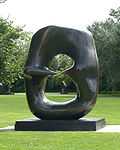Draped Reclining Figure, 1952–53
From Wikipedia, the free encyclopedia
 | |
| Artist | Henry Moore |
|---|---|
| Year | 1952-6 |
| Type | Bronze |
| Dimensions | (40 7/8 in × 66 5/8 in × 34 1/8 in) |
Draped Reclining Figure, 1952–53 is a bronze sculpture by Henry Moore.[1][2]
Examples
The sculpture, catalogued as "LH 336", was cast in an edition of four (or "3+1"; one being retained by the artist); there is also a cast study for the work (LH 705) which is on display at Castleford Civic Centre and the Rozelle House Gallery in Ayr.[3] The artist's copy was given to the Henry Moore Foundation and is on display in their sculpture garden around his old house at Perry Green, Hertfordshire.[4] Other copies in the edition are in the Hirshhorn Museum and Sculpture Garden in Washington D.C.,[5][6] and the Museum Ludwig in Cologne, Germany.[7]
Origin
The work was a precursor to later draped figures and, according to the artist's foundation, itsuccessfully added the contours of natural forms as well as a distinct hint of classicism to the repose of his figures, yet preserved that sense of immutability conveyed by the Mexican Chacmool figures, that had so profoundly influenced the younger artist.[8]
References
- ↑ "Draped Reclining Figure, (sculpture)". SIRIS
- ↑ "Draped Reclining Figure 1952-53 (LH 336)", Henry Moore Works in Public
- ↑ Henry Moore Foundation, LH 705
- ↑ Henry Moore Foundation, LH 336
- ↑ Smithsonian
- ↑ http://hirshhorn.si.edu/visit/in_depth.asp?key=33&subkey=102
- ↑ Henry Moore Foundation, LH 336 search
- ↑ Henry Moore Foundation, LH 705
External links
This article is issued from Wikipedia. The text is available under the Creative Commons Attribution/Share Alike; additional terms may apply for the media files.
